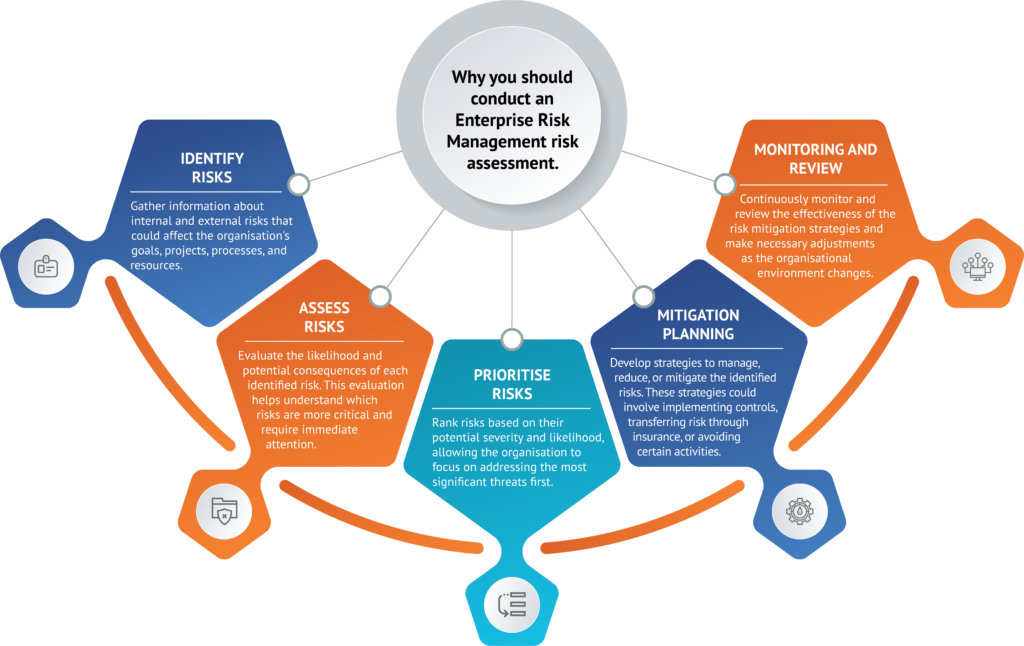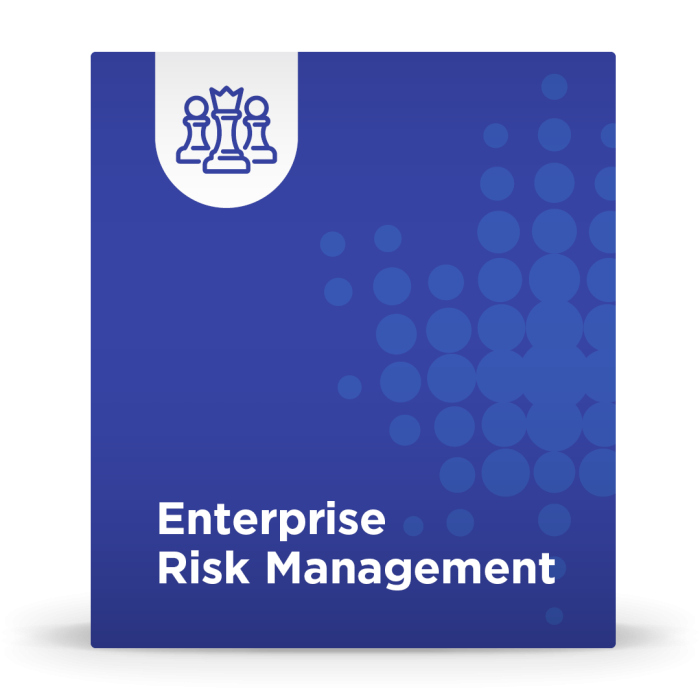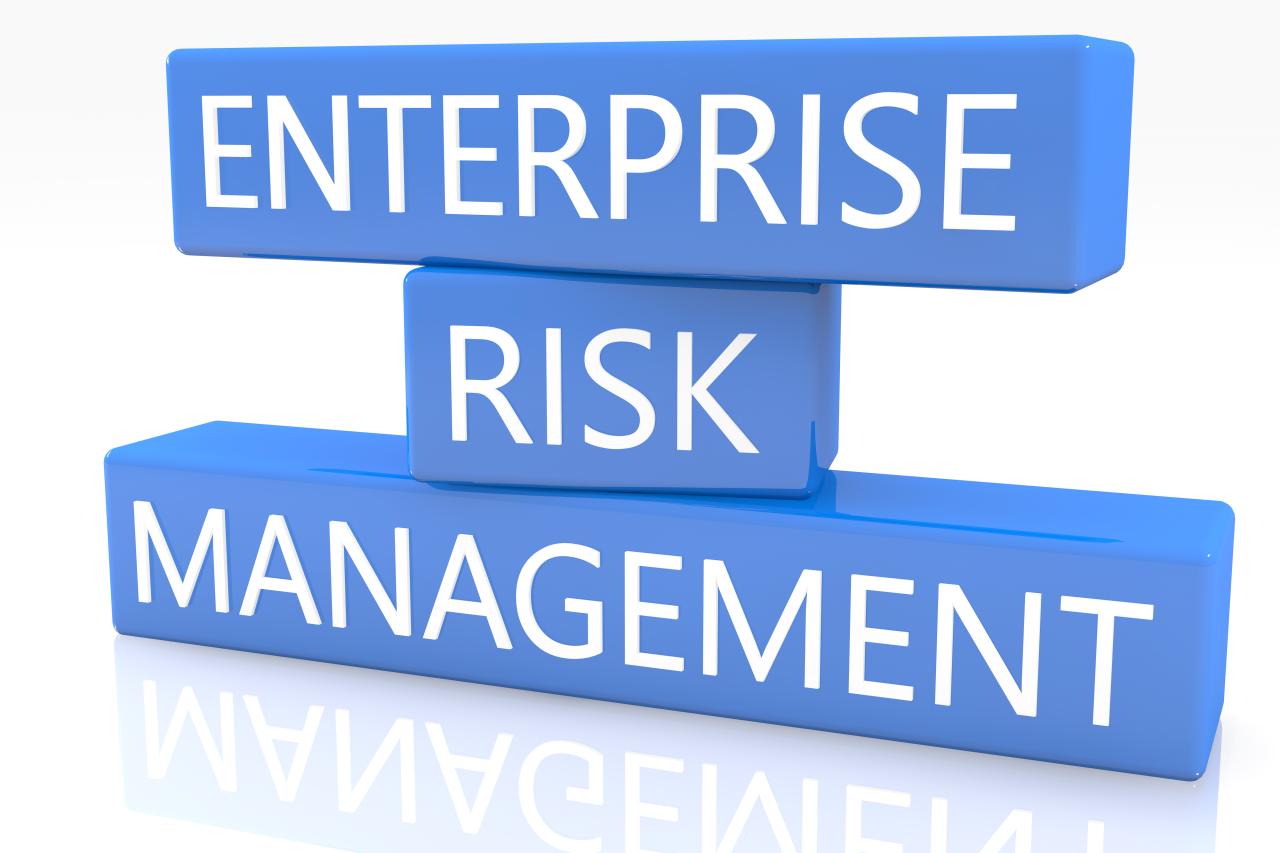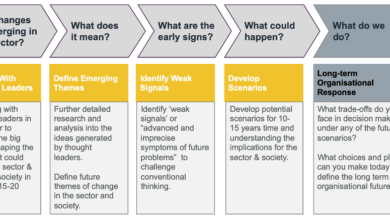
Companies Shape Enterprise Risk Management
Companies shape enterprise risk management, influencing how businesses approach and handle potential threats. This involves a complex interplay of culture, leadership, and organizational structure. Understanding these factors is key to developing effective risk management strategies, from initial assessment to ongoing monitoring. This exploration dives deep into how companies navigate risk, emphasizing the vital role of technology and communication in modern enterprise risk management.
Companies face various risks, from operational hiccups to strategic miscalculations. A robust enterprise risk management (ERM) framework is crucial for mitigating these challenges and achieving business objectives. This framework should encompass a structured approach, a risk-aware culture, and the ability to adapt to changing circumstances.
Defining Enterprise Risk Management (ERM)
Enterprise Risk Management (ERM) is a crucial process for any organization, large or small. It’s not just about identifying and mitigating potential threats; it’s about proactively shaping the future by understanding and managing all facets of risk that can affect an organization’s strategic objectives. ERM is a dynamic, integrated framework that helps companies navigate uncertainty and achieve sustainable success.This proactive approach to risk management encompasses a broad spectrum of risks, from financial volatility to operational inefficiencies and even strategic missteps.
A robust ERM system empowers organizations to make informed decisions, allocate resources effectively, and adapt to changing market conditions.
Defining Enterprise Risk Management
Enterprise Risk Management (ERM) is a comprehensive and integrated process for identifying, assessing, and managing all potential risks that an organization faces. It aims to optimize value creation while minimizing potential negative impacts. The scope extends beyond traditional risk areas, including financial and operational risks, to encompass strategic, reputational, and compliance risks. ERM is not a one-time event but an ongoing process that should be embedded into the organization’s culture and decision-making processes.
Types of Risks
Companies face a multitude of risks, categorized by source. Understanding these categories is crucial for developing effective mitigation strategies.
- Operational Risks: These risks stem from internal processes, systems, or human error. Examples include equipment malfunctions, supply chain disruptions, or inadequate internal controls. A critical element is the consistent evaluation and improvement of operational efficiency.
- Financial Risks: These risks relate to the organization’s financial standing. Examples include interest rate fluctuations, currency exchange rate changes, credit risk, and market volatility. Financial risks can significantly impact profitability and cash flow, highlighting the need for effective hedging strategies and financial forecasting.
- Strategic Risks: These risks relate to the organization’s long-term goals and direction. Examples include technological advancements disrupting existing market positions, regulatory changes, or competitive threats. Organizations must constantly evaluate their strategic positioning and adapt to market trends to mitigate these risks.
- Reputational Risks: These risks arise from negative publicity, scandals, or damage to the company’s brand image. Public perception and maintaining a positive brand image are essential for long-term success. Effective crisis communication plans are vital.
- Compliance Risks: These risks stem from failing to adhere to laws, regulations, and industry standards. Examples include legal proceedings, fines, or reputational damage. Maintaining compliance through robust legal and regulatory frameworks is critical.
Importance of a Structured Approach to ERM
A structured approach to ERM provides a framework for organizations to systematically identify, assess, and manage risks. This systematic process enables organizations to make informed decisions based on a thorough understanding of potential threats. A structured approach also fosters a culture of risk awareness and accountability across the organization, ensuring that risks are not overlooked or underestimated.
Key Principles of ERM
Implementing ERM requires adhering to key principles. These principles provide a framework for successful risk management.
- Integration: ERM should be integrated into all aspects of the organization’s operations, from strategy development to day-to-day decision-making. This ensures that risk considerations are central to all business activities.
- Culture of Risk Awareness: Fostering a culture of risk awareness throughout the organization is essential. Employees at all levels should understand their roles in identifying, assessing, and managing risks. Open communication and collaboration are key.
- Proactive Approach: ERM is not just about reacting to crises. It’s about proactively identifying and managing potential risks before they escalate. Proactive measures often prevent significant losses.
- Continuous Improvement: ERM is an ongoing process. Regular review and updating of the ERM framework are crucial to adapting to changing circumstances and emerging risks. Flexibility and continuous adaptation are critical for effectiveness.
- Accountability: Clear lines of accountability for risk management should be established. Individuals and teams should be responsible for managing risks within their respective areas of responsibility. Holding individuals accountable ensures that risks are addressed.
Company Influence on ERM

Enterprise Risk Management (ERM) isn’t a one-size-fits-all solution. Its effectiveness hinges heavily on the unique characteristics of the company implementing it. From the ingrained culture to the leadership style, organizational structure, and even the industry, a myriad of factors influence how well ERM functions. This exploration delves into these crucial aspects.The success of any ERM initiative is deeply intertwined with the prevailing company culture.
A risk-averse culture, where employees are encouraged to identify and report potential risks, is far more conducive to effective ERM than one where such behavior is discouraged or even penalized. A robust ERM framework will naturally struggle to flourish in a culture that prioritizes short-term gains over long-term sustainability.
Company Culture’s Impact on ERM
A strong risk-aware culture fosters a proactive approach to identifying and mitigating potential issues. Employees are empowered to voice concerns without fear of reprisal, leading to a more comprehensive understanding of risks. Conversely, a culture that emphasizes strict adherence to procedures, while seemingly protective, can stifle innovation and the identification of emerging risks. Open communication channels, transparent reporting mechanisms, and a clear understanding of the company’s risk appetite are key components of such a culture.
Leadership’s Role in Fostering a Risk-Aware Environment
Leaders play a pivotal role in shaping the company’s risk culture. A leadership team that actively promotes risk awareness and incorporates risk considerations into strategic decision-making creates a culture where ERM is valued and respected. Leaders who model risk-conscious behavior – being transparent about risks, taking calculated risks, and owning up to failures – establish a strong foundation for a robust ERM program.
Conversely, leadership that ignores or dismisses risk signals creates an environment where ERM is seen as an unnecessary burden.
Factors Contributing to a Company’s Risk Appetite and Tolerance
A company’s risk appetite and tolerance are not static. They are dynamic and influenced by factors such as industry trends, regulatory changes, financial performance, and competitive pressures. A company with a high risk tolerance, for example, might be willing to take on more significant risks for the potential of higher rewards, but may also be more susceptible to losses.
Conversely, a low risk tolerance indicates a preference for avoiding significant risks, but may potentially hinder growth opportunities. Assessing and documenting the company’s risk appetite and tolerance are crucial steps in designing an effective ERM framework.
Influence of Organizational Structure on Risk Management Processes
The organizational structure significantly impacts how risk management processes are implemented and monitored. A centralized risk management function, for example, can provide greater oversight and consistency across the organization. However, it can also create communication bottlenecks. A decentralized approach might empower employees at various levels to identify and respond to risks more quickly but could lead to inconsistencies in risk assessment and management.
The ideal structure balances centralization and decentralization, enabling efficient communication while empowering local teams to act decisively.
Comparison of ERM Practices Across Industries
ERM practices vary considerably across industries. In the finance sector, regulatory compliance is paramount, influencing ERM frameworks to meticulously address financial risks, credit risks, and market risks. The technology sector, while dealing with different types of risks, often prioritizes operational efficiency and emerging technologies, requiring ERM to incorporate rapid technological advancements and cybersecurity threats into their strategies. Comparing ERM practices across industries highlights the need for industry-specific adaptation of ERM frameworks to address unique risk profiles.
Risk Assessment and Strategy Development
Enterprise Risk Management (ERM) hinges on a robust risk assessment process. Companies must meticulously identify, analyze, and prioritize potential risks to effectively develop strategies for mitigation and response. This process isn’t a one-time exercise; it’s an ongoing cycle that adapts to changing business environments and emerging threats. A well-structured risk assessment and subsequent strategy development are crucial for a company’s resilience and long-term success.Effective risk management isn’t just about identifying threats; it’s about understanding their potential impact and likelihood, and then formulating proactive responses.
This involves a systematic approach, leveraging various methodologies to gain a comprehensive view of the risk landscape. By prioritizing risks, companies can allocate resources effectively, focusing on those threats with the highest potential impact. This prioritization, combined with well-defined mitigation strategies, enables companies to build resilience and minimize potential disruptions.
Risk Assessment Methodologies
Companies employ a variety of methodologies to assess risks. These methods often incorporate qualitative and quantitative techniques, each offering unique insights into potential threats. Some common methodologies include scenario planning, SWOT analysis, and key risk indicator (KRI) monitoring. Scenario planning allows companies to anticipate and prepare for various potential outcomes, while SWOT analysis helps identify internal strengths and weaknesses, and external opportunities and threats.
KRIs, measurable indicators, help companies track and monitor the key risks that could significantly impact the organization. Each method contributes to a more comprehensive understanding of the risk landscape, providing a more holistic view of potential challenges.
Risk Prioritization and Categorization
Companies prioritize risks based on their potential impact and likelihood. A common framework involves using a matrix, often a combination of qualitative and quantitative data. The matrix typically categorizes risks based on the likelihood of occurrence (e.g., low, medium, high) and the potential impact (e.g., low, medium, high). Risks that fall into the high-impact, high-likelihood category receive immediate attention, whereas those with lower likelihood and impact are often managed with a lower level of priority.
This prioritization enables companies to allocate resources efficiently, focusing on the most significant threats. This approach can be adjusted based on the industry and company-specific circumstances.
Translating Risk Assessments into Actionable Strategies
A critical step in the ERM process is translating risk assessments into actionable strategies. This involves developing specific mitigation strategies to reduce the likelihood or impact of identified risks. For example, if a risk assessment identifies a potential supply chain disruption as high-impact and high-likelihood, a company might implement strategies like diversifying its suppliers, building inventory reserves, or developing contingency plans.
Companies often use a structured approach, creating detailed action plans for each risk, clearly outlining responsibilities, timelines, and resources needed. This approach ensures that the strategies are effectively implemented and monitored.
Examples of Risk Mitigation Strategies
Numerous risk mitigation strategies are employed by companies across various industries. For instance, a company in the manufacturing sector might implement quality control measures to reduce the risk of product defects. In the financial sector, diversification of investments is a common strategy to reduce the impact of market fluctuations. Companies often implement several strategies simultaneously to address different aspects of a risk.
The chosen strategies depend on the specific risk and the company’s risk tolerance.
Risk Response Plans and Contingency Plans
Risk response plans Artikel the specific actions to be taken in the event of a risk materializing. These plans detail the steps to be taken, responsibilities, and resources needed. Contingency plans are a critical component of risk response plans, providing backup strategies for dealing with unexpected events or disruptions. These plans are often crucial in ensuring business continuity and minimizing potential damage.
The effectiveness of risk response plans relies heavily on thorough preparation, regular testing, and adaptation to evolving circumstances.
Technology’s Impact on ERM
Technology has revolutionized enterprise risk management (ERM), enabling companies to identify, assess, and monitor risks with unprecedented speed and accuracy. The integration of sophisticated software and data analytics tools empowers organizations to proactively address potential threats and safeguard their operations. From streamlining processes to predicting future risks, technology is transforming how companies approach ERM.
Enhanced Risk Identification, Assessment, and Monitoring
Technology facilitates the collection and analysis of vast amounts of data, enabling companies to identify and assess risks more comprehensively. Real-time monitoring systems can detect anomalies and potential threats, providing immediate alerts and enabling proactive responses. For instance, sophisticated fraud detection systems can flag unusual transactions, preventing significant financial losses. Data visualization tools allow risk managers to understand complex patterns and relationships, leading to a more holistic view of potential vulnerabilities.
Leveraging Data Analytics for Risk Management
Data analytics plays a critical role in modern ERM. Companies leverage historical data, market trends, and internal performance metrics to identify potential risks. Statistical models can predict the likelihood and impact of various events, providing valuable insights for decision-making. Predictive modeling can identify emerging trends and potential disruptions, such as supply chain bottlenecks or regulatory changes, allowing companies to adapt and mitigate risks.
Streamlining ERM Processes with Automation
Automation tools have significantly streamlined ERM processes, reducing manual effort and improving efficiency. Automated workflows can expedite tasks like risk reporting, compliance checks, and incident management. This frees up risk management personnel to focus on strategic initiatives and more complex analysis. Furthermore, automated reporting tools produce comprehensive and timely risk reports, ensuring transparency and accountability.
Comparison of Risk Management Software Solutions
| Software Solution | Features | Pricing | Vendor Support |
|---|---|---|---|
| Riskonnect | Comprehensive risk assessment, scenario planning, and reporting capabilities. | Typically tiered pricing based on user needs and features. | Strong reputation for dedicated support and extensive resources. |
| Protiviti | Provides risk assessment, compliance management, and audit solutions. | Customizable pricing based on the scope of services and implementation. | Known for its expert consultants and industry knowledge. |
| RIMS | Offers a wide range of risk management solutions, from property and casualty to financial risk. | Pricing structures vary depending on the specific solutions and services required. | Reputable for their comprehensive training and resources. |
| Oracle | Integrates risk management into a wider enterprise resource planning (ERP) system. | Pricing is often bundled with other Oracle solutions. | Extensive support network through the Oracle ecosystem. |
Note: Pricing and features can vary significantly based on the specific implementation and customizations required. It is crucial to evaluate these factors when choosing risk management software.
AI in Predicting and Mitigating Risks, Companies shape enterprise risk management
Artificial intelligence (AI) is rapidly transforming risk management, enabling companies to predict and mitigate risks more effectively. Machine learning algorithms can analyze vast datasets to identify patterns and anomalies that might otherwise go unnoticed. For example, AI can identify fraudulent activities by detecting subtle deviations from normal behavior. AI-powered risk scoring systems can prioritize risks based on their likelihood and potential impact, enabling companies to focus their resources on the most critical threats.
Furthermore, AI can anticipate emerging risks by analyzing market trends and regulatory changes, giving companies a crucial advantage in adapting to evolving conditions. One example is the use of AI in fraud detection, where algorithms can identify patterns and anomalies in transactions that humans might miss.
Communication and Reporting

Effective communication about risk management is crucial for a company’s success. Open and transparent communication channels allow for early identification of potential issues, facilitate proactive risk mitigation strategies, and foster a culture of accountability. This, in turn, strengthens stakeholder confidence and promotes a more resilient organization. Without proper communication, risks can escalate undetected, leading to financial losses, reputational damage, and legal repercussions.Risk information needs to be disseminated across all levels of the organization, from the boardroom to frontline employees.
This ensures everyone understands their roles in managing risks and fosters a shared understanding of the company’s overall risk profile. Clear communication fosters a culture of risk awareness and encourages employees to report potential issues proactively.
Importance of Internal Communication
Internal communication about risk management is paramount. Employees at all levels must understand their roles in identifying, assessing, and mitigating risks. This promotes a shared understanding of the organization’s risk profile and encourages proactive reporting of potential issues. A culture of open communication fosters accountability and empowers employees to contribute to the overall risk management strategy.
Reporting Mechanisms for Stakeholders
Various reporting mechanisms are employed by companies to communicate risk information to stakeholders. This ensures transparency and facilitates informed decision-making.
| Reporting Mechanism | Description | Stakeholder Focus |
|---|---|---|
| Board Meetings | Formal presentations on key risks, mitigation strategies, and performance against risk targets. | Board members, senior management |
| Management Reports | Regular reports summarizing risk exposures, key controls, and potential issues. | Senior management, executives |
| Financial Statements | Risk information integrated into financial reporting, highlighting potential financial implications. | Investors, creditors, regulatory bodies |
| Compliance Reports | Documentation of compliance with regulations and internal policies related to risk management. | Regulatory bodies, auditors |
| Employee Newsletters/Intranets | Summarized risk information communicated to all employees. | All employees |
Significance of Risk Reviews and Audits
Regular risk reviews and audits are vital for maintaining a robust risk management framework. They help ensure the effectiveness of existing controls, identify emerging risks, and ensure that the risk management process remains current and relevant. Risk reviews and audits are a critical component of the risk management cycle, providing a crucial assessment of the organization’s ability to handle potential disruptions.
Clear and Understandable Presentation of Risk Information
Presenting risk information in a clear and understandable manner is essential for effective communication. Using visual aids, such as charts and graphs, can greatly enhance comprehension. Quantifiable data, like percentages and financial figures, makes the information more impactful. Presenting risk information in a clear and understandable format helps ensure that all stakeholders can grasp the key points and make informed decisions.
For example, presenting the likelihood and impact of a risk in a matrix format provides a concise summary of its severity. Presenting risk information in a format that is relevant to the audience’s needs will improve understanding and ensure the message is properly received.
Legal and Regulatory Aspects of Risk Reporting
Companies are often subject to specific legal and regulatory requirements regarding risk reporting. These regulations dictate the level of detail, frequency, and format of risk disclosures. Non-compliance with these regulations can lead to severe penalties. For example, financial institutions are required to disclose certain risk factors in their annual reports to ensure investors have the necessary information to make sound investment decisions.
Companies must ensure that their risk reporting practices comply with all applicable regulations. Compliance with reporting standards helps maintain transparency and trust with stakeholders.
Measuring ERM Effectiveness: Companies Shape Enterprise Risk Management
Evaluating the effectiveness of an Enterprise Risk Management (ERM) program is crucial for demonstrating its value and identifying areas for improvement. A robust measurement framework allows companies to understand if their ERM strategy is aligned with their objectives and if the implemented controls are functioning as intended. This process often involves a multifaceted approach that goes beyond simply identifying risks.Measuring ERM effectiveness is not a one-size-fits-all process.
Companies need to tailor their metrics to reflect their specific industry, size, and risk profile. This involves a careful consideration of how the ERM program is impacting the company’s overall performance and the ability to mitigate potential risks. The key lies in identifying the relevant key performance indicators (KPIs) and tracking them consistently over time.
Metrics for Measuring ERM Program Effectiveness
Companies use a variety of metrics to gauge the effectiveness of their ERM programs. These metrics typically encompass both qualitative and quantitative data. Qualitative data might include feedback from employees on the clarity and usefulness of risk management processes, while quantitative data might focus on the frequency of identified and mitigated risks. Key indicators should be aligned with the overall business strategy and the specific risks faced by the company.
Tracking Key Performance Indicators (KPIs)
Companies track KPIs related to risk management to assess the performance of their ERM programs. These KPIs can include the number of risks identified, the number of risks mitigated, the frequency and severity of incidents, and the timeliness of responses to risks. By tracking these KPIs over time, companies can identify trends and patterns that can inform adjustments to their risk management strategies.
This also enables a more targeted approach to risk management, allowing for focused efforts on areas where improvements are needed. For instance, if the frequency of incidents related to supply chain disruptions is increasing, the company can focus its ERM efforts on strengthening supply chain resilience.
Assessing Return on Investment (ROI) of ERM Initiatives
Quantifying the ROI of ERM initiatives requires careful analysis. Companies use data to assess the potential financial impact of risks and the effectiveness of controls implemented to mitigate them. This can involve comparing the cost of implementing ERM controls to the potential financial losses avoided. For example, a company might calculate the potential loss from a data breach and compare it to the cost of implementing a robust cybersecurity program.
The result provides a clear picture of the return on investment of these risk management strategies.
Best Practices in Measuring ERM Effectiveness
| Category | Best Practice |
|---|---|
| Risk Identification | Use a structured approach for identifying potential risks, encompassing both internal and external factors. |
| Risk Assessment | Employ a consistent risk assessment methodology, taking into account both likelihood and impact. |
| Risk Response | Develop and implement appropriate risk response strategies, aligning them with the company’s risk appetite. |
| Monitoring and Evaluation | Establish a robust monitoring and evaluation system to track the effectiveness of the ERM program. |
| Reporting and Communication | Communicate ERM findings and insights clearly and transparently to stakeholders. |
Adapting ERM Strategies Based on Performance Data
Performance data from the ERM program provides valuable insights for adapting strategies. Analyzing trends in risk occurrences, the effectiveness of controls, and the overall performance of the program allows for continuous improvement. For instance, if a particular risk mitigation strategy proves ineffective, the company can adjust its approach to incorporate more robust controls or explore alternative strategies. This iterative process ensures that the ERM program remains aligned with the evolving risk landscape and the company’s objectives.
Case Studies of Company ERM
Enterprise Risk Management (ERM) is no longer a luxury but a necessity for companies navigating an increasingly complex and unpredictable business environment. Successful ERM implementation demonstrates a company’s proactive approach to identifying, assessing, and mitigating potential threats. Examining real-world case studies provides valuable insights into effective strategies, highlighting the challenges faced and the long-term benefits realized.Understanding how leading organizations have implemented ERM provides a blueprint for other companies seeking to enhance their resilience and profitability.
These examples offer practical applications of theoretical frameworks and demonstrate the tangible results that can be achieved through a well-structured ERM program.
Examples of Companies with Successful ERM Implementations
Several companies have successfully integrated ERM into their core operations, leading to significant improvements in performance and risk mitigation. Examples include companies in various sectors, demonstrating the adaptability of ERM principles.
- Johnson & Johnson: Known for its robust risk management processes, J&J’s ERM framework proactively identifies and mitigates potential risks across its diverse product portfolio. This proactive approach has helped the company maintain a high level of public trust and operational stability. Their culture of ethical conduct and risk awareness is a cornerstone of their success.
- General Electric (GE): GE’s ERM program is well-regarded for its emphasis on strategic alignment. They integrate risk considerations into their strategic planning process, ensuring that risk appetite is clearly defined and embedded in decision-making across the organization. This has resulted in a more resilient and adaptable business model.
- Walmart: Walmart’s ERM program focuses on operational efficiency and supply chain resilience. Their extensive network and vast inventory require a robust risk management framework. This includes managing risks related to supply chain disruptions, inventory management, and maintaining ethical labor practices. This approach is critical to ensuring the smooth functioning of a massive retail operation.
Challenges Faced and Overcoming Them
Implementing ERM isn’t without its hurdles. Companies often encounter obstacles in establishing a clear risk appetite, integrating risk management into daily operations, and ensuring buy-in from all levels of the organization.
- Resistance to Change: Organizational resistance to adopting new processes and procedures can be a significant challenge. Companies need to foster a culture of risk awareness and actively communicate the benefits of ERM to all stakeholders.
- Data Integration Issues: Gathering and integrating data from various sources can be complex. Companies must develop robust data management systems to ensure accurate and timely risk assessments. Implementing a unified data platform and ensuring data quality are critical.
- Lack of Skilled Personnel: ERM requires specialized expertise. Companies may struggle to find personnel with the necessary skills to implement and maintain the ERM program. Investing in training and development is essential to build internal ERM capabilities.
Successful ERM Implementation Methodologies
A structured approach is crucial for successful ERM implementation.
- Establish a Clear Risk Appetite: Define the acceptable level of risk the organization is willing to tolerate. This framework should be communicated clearly and consistently throughout the organization.
- Develop a Comprehensive Risk Register: Identify, assess, and categorize all potential risks. A detailed risk register ensures a complete inventory of potential threats. This allows for prioritizing and focusing efforts on the most significant risks.
- Integrate ERM into Strategic Planning: Incorporate risk considerations into strategic planning processes, ensuring that potential risks are addressed and mitigated. This ensures risks are considered throughout the decision-making process.
- Establish Metrics and Reporting Mechanisms: Establish clear metrics to measure the effectiveness of the ERM program and develop a consistent reporting mechanism to track performance.
Long-Term Impacts on Company Performance
Effective ERM implementation can yield substantial long-term benefits. Companies with well-established ERM frameworks often demonstrate increased profitability, enhanced operational efficiency, and a stronger brand reputation.
- Improved Decision Making: ERM provides a structured framework for making informed decisions by incorporating risk considerations into the decision-making process.
- Enhanced Resilience: Companies with robust ERM programs are better equipped to handle unexpected events and market fluctuations, ensuring operational continuity and minimizing disruptions.
- Increased Shareholder Value: By proactively managing risks, companies can improve their financial performance and enhance investor confidence, leading to increased shareholder value.
Lessons Learned from These Case Studies
The case studies highlight the importance of a holistic approach to risk management, emphasizing the need for strong leadership support, comprehensive risk assessment, and continuous improvement. The importance of integrating ERM into the company’s culture is evident.
- Proactive Risk Management: The importance of proactively identifying and mitigating potential risks cannot be overstated.
- Clear Communication: Clear communication of risk strategies and their impact on the company is crucial for successful implementation.
- Continuous Improvement: ERM is an ongoing process. Regular reviews and adjustments are necessary to ensure the program remains effective and relevant in a dynamic environment.
Outcome Summary

In conclusion, companies shape enterprise risk management through their culture, leadership, and organizational structure. Effective risk management hinges on a multifaceted approach, integrating technology, communication, and robust reporting mechanisms. The ability to adapt and learn from experiences is critical for success. This journey reveals that a proactive and data-driven approach to risk management ultimately leads to stronger, more resilient businesses.
Clarifying Questions
What are some common types of risks faced by companies?
Companies face a variety of risks, including operational risks (e.g., supply chain disruptions), financial risks (e.g., market volatility), strategic risks (e.g., competitive pressures), and reputational risks (e.g., negative publicity).
How can technology be leveraged for better risk management?
Technology can enhance risk management by automating tasks, improving data analysis, enabling faster response times to threats, and facilitating better communication. This includes using AI and machine learning to predict and mitigate risks.
What metrics are used to measure ERM effectiveness?
Companies use various metrics, including key performance indicators (KPIs) related to risk events, the frequency and severity of incidents, and the return on investment (ROI) of risk mitigation strategies. Benchmarking against industry best practices is also valuable.
What is the role of leadership in ERM?
Leadership plays a crucial role in fostering a risk-aware culture within the organization. Leaders must demonstrate commitment to risk management, empower employees to identify and report risks, and ensure resources are available for effective risk mitigation.





